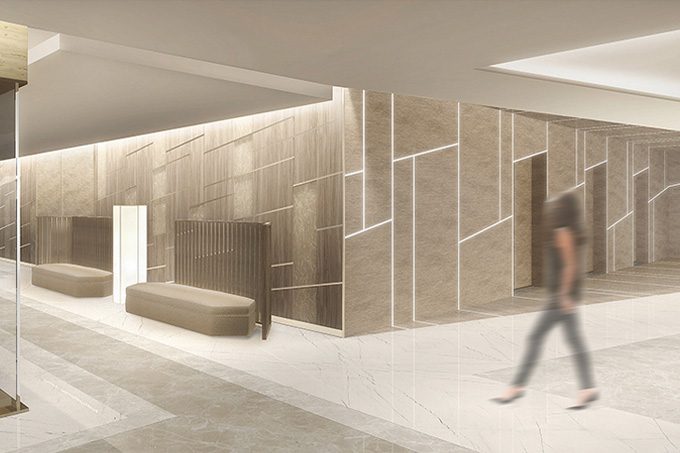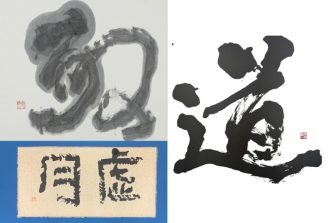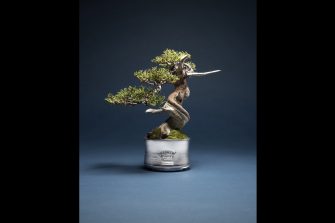
これまでにない空間の力で、銀座の新しいスタートポイントに An Unprecedented Space That Marks a New Starting Point for Ginza
INTERIOR
グエナエル・ニコラ
商業施設を考える3つのポイント
今回のような商業施設のプロジェクトには3つのポイントがあると思います。一つは空間にアイコニックなエレメントを作らなければならないこと。例えば、今の時代はフォトジェニックだけでなく、メディアジェニックも大切です。施設を訪れた人々が写真を撮るときに「ここはGINZA SIXだね」と一目でわかる場所が必要で、パリの街で言えば、エッフェルタワーみたいなものですね。GINZA SIXでは2階の大きな吹き抜けのアトリウムをアイコンに据えています。
二つ目は、さまざまなストーリーボードを作ってシミュレーションをすることで、空間のなかの人の動きをデザインすること。ある場所からある場所まで何分かかるのか。その場合、エレベーターはもう一基必要ではないか。このあたりで光に出会いたいので、吹き抜けを設けようか…。空間のエネルギーが自然と循環し、人間の感情や身体感覚に対してストレスのない空間であること。ここは建築家とのコラボレーションが必要な部分でもあります。
最後の三つ目は、ダイナミックな空間とリラックスできる空間という緩急を設けること。商業施設で買い物をするスピードは人によって異なります。GINZA SIXではほっと一息付ける空間として、オリジナルでデザインしたソファをコクーンのようなプロポーションにし、背後に木の屏風を置いて、インティメートな空間を作り出しています。
一方で壮大なスケールのフロアが単調にならないように、銀座の裏に残る小さな路地などをイメージし、ショップが並ぶ通路をジグザグにデザインしました。そのジグザグによってすべての店に角が生まれ、通常の商業施設のように一つの通りを直線的に見渡せないことで、まさに路地の通りを歩きながら一つ一つの店に出会う高揚感を味わうことができるようになっています。
The Three Essential Elements of a Shopping Mall
When it comes to designing a shopping mall like GINZA SIX, I believe there are three essential elements. One is the need for an iconic element within the space. Namely, in this day and age, it is important to be not only photogenic, but media-genic as well. Much like when people visit Paris they take the obligatory Eiffel Tower photo, you need something instantly recognizable as GINZA SIX that guests will naturally be inclined to snap a picture of. At GINZA SIX, we've positioned the large four-story atrium on the second level as our central picture-worthy attraction.
Second is to design the flow of people through the space using storyboards to simulate various scenarios. How many minutes does it take to get from point A to point B? Wouldn't it be easier if there were another elevator there? I'm thinking people will want to encounter some sunlight right around here—how about we make this an atrium?...It's absolutely key that the energy of the space flows naturally, and that no physical or emotional stress is placed on the guests. This part involves working together with the architect.
The third element is to provide variation: dynamic shopping experiences as well as areas of calm to sit down and relax. It's important to remember that everybody browses and shops at a different pace. For GINZA SIX, we've created an intimate premium lounge where guests can catch their breath, complete with custom-designed sofas that are so comfortable it's as if you were being wrapped in a cocoon, and a backdrop of wooden byobu [decorative multi-panel folding screens that serve as room partitions].
Also, in order to impart a sense of wonder on guests as they walk through the spectacular retail levels, we've set up the walkways in a zigzag orientation, evoking Ginza's narrow side streets and back alleys that remain to this day. The zigzags give each store a corner that faces out into the walkway—which means that unlike your standard inline shopping mall where you have a straight line of sight from one end to the other, guests naturally come face to face with each store as they walk around, and this creates a feeling of excitement about what could be around the next corner.

第一に誰のための空間であるべきか
GINZA SIXは世界中から人々を招き入れる、インターナショナルな商業施設になると思います。ただ、インテリアには日本のエッセンスを入れたかった。外から来る方々を意識するのは大切ですが、まずは日本に住む私たちや自分の家族が喜べる空間を作りたかったのと、そこからズレてはいけないように思いました。
例えば日本の建築では障子や行灯でふんわりとした光を行き渡らせる工夫がなされていますが、GINZA SIXでは吹き抜けのアトリウムの天井に3Dの和紙をあつらえて、トップライトから落ちる自然の光を優しく透過し、その光が全体に回るようにしています。階段の手すりにはルーバーを用い、竹をイメージした格子をあしらいました。
空間を引き締めるクラフツマンシップをどう見せるかにもこだわりました。できるだけハンドメイドの素材を使うようにして、一部のエレベーターホールの壁はアルミの表面をテクスシャーのあるラッカーで仕上げています。ショップが並ぶ通路の壁にはポイントごとに職人による和紙を使用しました。こうした素材のレイヤーやクオリティでどう空間を見せるかは、GINZA SIXに限らず、私のすべてのプロジェクトに通じるデザインのポイントでもあって、日本のデザインもやはりレイヤーとクオリティで成り立っているとも言えます。ただし、今回は壮大なスケールのGINZA SIXが大きな工場のような印象を与えないために、そのバランスに気を配っています。
GINZA SIXが掲げる"New Luxury"というのも「これがすごいよね」と一点で語られるものではなく、あくまで全体を通して感じるものではないでしょうか。インテリア以外にも、建築があって、グラフィックがあって、アートがあって、能楽堂のような文化もあって、自然が感じられて、ホスピタリティがあるということ。逆に言うと、高級旅館であってもビジネスホテルであってももしかしたら大差はなくて、全体のバランスがよければ、「どちらもすごいね」ということになるのだと思います。
Who Should the Space Be For?
I believe that GINZA SIX will become an international shopping mall that will attract guests from around the world. But in spite of that—or maybe even because of that—I wanted to imbue the interior design with the essence of Japan. While it is important to keep in mind that many of our prospective patrons will be from outside of Japan, my first priority was to design a space that our team of designers, our families, and those of us who live here in Japan would enjoy coming to. It was critical not to lose sight of that.
For example, in Japanese architecture, you use fixtures like shoji [sliding screens made of translucent paper over a wooden frame] and lanterns to diffuse light throughout a space. At GINZA SIX, I had 3D washi [a Japanese style of paper commonly made using fibers from the bark of mulberry trees, paperbush, and Gampi trees] incorporated into the ceiling of the atrium in order to diffuse the natural light coming through the skylight and bathe the retail levels in gentle light. And for the staircases we've installed louver railings with latticework designed to resemble bamboo.
I was also very particular about how attention to detail and touches of craftsmanship are used to bring the space together. Wherever possible, I integrated handmade and handcrafted elements. A number of the elevator hallways, for example, have walls covered in aluminum with a lacquer finish. And along the walls of the main walkways, you'll come across creative use of washi made by an expert papermaker. Using layers of design and the unique qualities of individual materials to bring a space to life—this has always been a central characteristic of my work, and GINZA SIX is no exception. And you can say that the use of layers and qualities are the foundation of Japanese design as well. So with a space as grand as GINZA SIX, it was important to achieve a balance between the two, so that it didn't end up feeling like some large industrial factory.
GINZA SIX's vision of "New Luxury" is not something that draws attention to itself, not something you can pinpoint; rather, it's an aesthetic that permeates the entire undertaking from top to bottom. It applies not only to the interior design, but the architecture, graphic design, and artwork on display, as well as the Noh theater and other cultural attractions, greenery, and, of course, the service and hospitality. To put it another way, New Luxury is not about what or how much you do with a space, but whether or not what you do is right for the space. In that sense, whether you were to choose to spend the night at a high-end ryokan [traditional Japanese inn] or a business hotel, one experience is not necessarily more "luxurious" than the other, because it's a question of overall balance and the thought put into it. Again, not what or how much you can do for your guests, but whether or not what you do is right for your guests.


商業施設に必要な最後のレイヤー
私個人的には、銀座は裏通りが意外に面白いと感じています。美味しい飲食店もいっぱいありますし、アート&クラフトの店、小さな建物の中にさまざまな業態の店が集まっていたりもして、インバウンド需要の波が押し寄せる表通りを歩くだけでは気づくことのできない、濃いカルチャーが残っている。インターナショナルな反面、日本のエッセンスが強い街でもあります。GINZA SIXには240ものショップが入りますが、まさに銀座の裏通りのような「さまざまなお店がいっぱいある面白さ」を出したいと思ってデザインをしました。
ところで、パリに「ボン・マルシェ」という世界最古の百貨店があります。私も大好きでパリに行くとよく買い物に出かけますが、ヒューマンスケールで、リテールのデザインが上手く、セレクションに長けていて、何より高級住宅街にあるので「左岸のお金持ち向け」というキャラクターがはっきりしている。結果、近所の住人でいつも賑わっていて、だから、観光客もやってくるという循環です。
すなわち、商業施設に必要な最後のレイヤーは「人」であり、そのクオリティであるということを忘れてはいけないと思います。GINZA SIXにもまず周辺に暮らす方々や職場がある人々、次に銀座に食事をしに来るような層を取り込んで、東京から日本、そこから海外の人に愛されていくようなメッセージやロジックが必要かもしれません。
皆さんは銀座に行くとき、どこを中心に捉えますか? もしかしたら、今は銀座4丁目の交差点かもしれません。でも、私は「とりあえずGINZA SIXで待ち合わせしましょう」という状況を作りたい。
これまでの商業施設にはないインテリアを持つGINZA SIXが、皆さんに愛されて、銀座の新しいスタートポイントになってくれることを願っています。
The Layer That Completes a Shopping Mall
Personally, I find Ginza's side streets and back alleys to be among its most intriguing features. They're lined with great places to eat, arts-and-crafts stores, and small buildings occupied by seemingly every type of business, and are where you'll find a deep-rooted culture that you would never encounter if you kept only to the main tourist thoroughfares. These streets are cosmopolitan, but at the same time they are infused with the essence of Japan. GINZA SIX will be home to 240 stores, but I designed the interiors to bring out that same Ginza side street feel of wandering into a delightful hodgepodge of establishments.
Incidentally, did you know that the world's oldest department store is Le Bon Marché in Paris? I'm such a big fan that I make several shopping trips each time I visit Paris. They're masters of retail design—the place is built to human scale, and their product selections are excellent—but most of all its location in an upscale residential area means that it caters to a clear demographic: the affluent class of the Left Bank. As a result, the place is always bustling with local residents, which in turn attracts tourists, and one feeds into the other.
In other words, the final layer that is absolutely necessary for a shopping mall is people—and not just anybody, but people of a particular poise and quality. With GINZA SIX, first and foremost we wanted to create a destination that captures the hearts of the people who live and work in the area. Then from there, we will expand that circle to the people that come to Ginza to have lunch or dinner, to all of Tokyo and then Japan, and last but not least, abroad. You need a message that is not one-size-fits-all, but adaptable and universal. It's a gradual process that has to be thought out and executed carefully.
When you visit Ginza, where do you think of as the center? Many point to the Ginza 4-chome intersection. My goal is that in the not too distant future people will be saying to each other "Let's meet up at GINZA SIX."
GINZA SIX is a shopping mall with an interior the likes of which has never been seen before. I hope that it captures your hearts and imaginations, and becomes a new starting point for Ginza.

グエナエル・ニコラ
1966年フランス生まれ。パリ、ロンドンでデザインを学び、1998年に東京でデザインスタジオ「キュリオシティ」を設立。近年ラグジュアリーブランドのストアをワールドワイドに多く手がけている。
Gwenael Nicolas
Born in France in 1966, Gwenael Nicolas studied design in Paris and London, and established design studio CURIOSITY in Tokyo in 1998. He is known for designing the interiors of many luxury brand stores in Japan and around the world.
(2016年9月インタビュー)
Interview and Text by Yuka Okada / Photographs by Satoko Imazu










